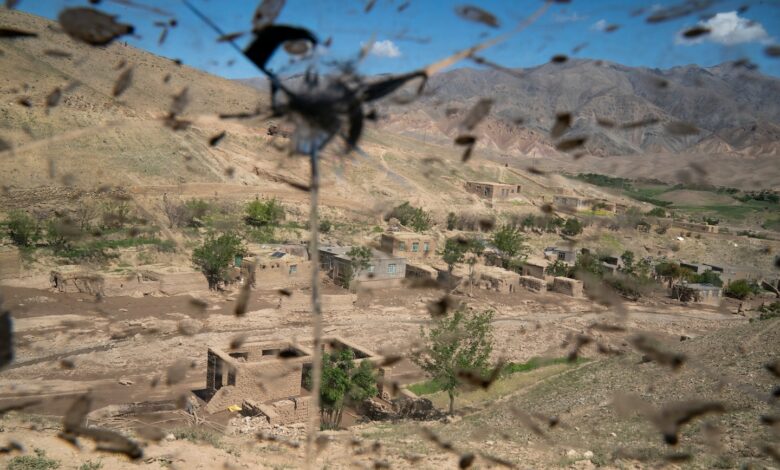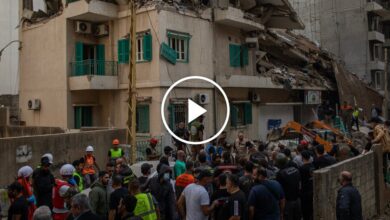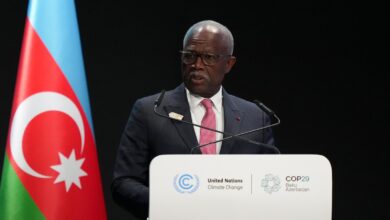Afghanistan’s Taliban rulers tackle climate change and blame foreigners

So, for now, the Afghan government is largely confronting the impacts of global warming on its own and putting the blame for floods and sluggish governmental aid on foreigners. Some former Taliban commanders view global carbon emissions as a new invisible enemy.
“Just like they invaded our country, they’ve invaded our climate,” Lutfullah Khairkhaw, the Taliban’s deputy higher education minister, said in his opening speech at the Jalalabad conference this year. “We must defend our climate, our water, our soil to the same extent we defend ourselves against invasions.”
With parched deserts and deforested, flood-prone valleys, Afghanistan is deemed by researchers to be among the 10 countries most vulnerable to climate change. Hundreds of people died, for instance, during recent flash floods that officials blamed on ominous changes in the climate.
Kanni Wignaraja, the regional director for Asia and the Pacific at the United Nations Development Program, said prolonged drought in Afghanistan has so hardened soils that flash floods are particularly violent here. “The damage is huge,” she said in an interview.
Before the Taliban takeover, international donors estimated that Afghanistan would need more than $20 billion between 2020 and 2030 to respond to climate change. The U.N. is still able to fund some projects in the country, but Wignaraja said the Taliban-run government is correct when it says that “global money for climate has dried up.”
While Taliban beliefs are rooted in centuries-old Pashtun culture and an extreme interpretation of Islam, the government affirms that climate change is real, that it’s destroying God’s work and that those in the world who reject the truth of climate change need to get on board. The Taliban has asked imams in Afghanistan’s tens of thousands of mosques to emphasize during Friday prayers the need for environmental protection.
Carbon footprints will weigh heavily on judgment day, said Kabul-based imam Farisullah Azhari. “God will ask: How did you make your money? And then he will ask: How much suffering did you cause in the process?” he said in an interview.
Modern science and age-old beliefs
Historically, the Taliban’s environmental activism was unrelated to modern climate science. The Quran encourages Muslims to plant trees, and locals recall how the Taliban flogged illegal loggers when the group was first in power in the late 1990s.
At the Taliban-run Afghanistan Science Academy in Kabul, religious scholars are now debating how to reconcile modern science with centuries-old religious beliefs.
“Climate change is real,” said Abdul Hadi Safi, professor of Islamic Studies and Management. “But if God doesn’t want something to happen, it won’t happen.”
Safi cited the frequent inaccuracy of his smartphone’s weather app to explain his reasoning. Making it rain even when Google says the sky should be sunny “is God’s way of saying: I’m the boss,” he said.
Some religious scholars at Taliban-run institutes fear that prolonged drought and the growing number of deadly floods in Afghanistan may at best be God’s punishment and at worst a sign of the apocalypse. Others allege a new chapter in American hegemony: a foreign plot to bring the Taliban-run regime to its knees by exposing it to natural disasters.
Members of the institute agree, however, that foreign powers are responsible for climate change, and it’s a religious duty to fight it.
Humvees and night-vision goggles
In Chesht-e-Sharif, a remote town in western Afghanistan, the Taliban’s battle against climate change is fought with American night-vision goggles and two of the Humvees that were seized after the U.S. withdrawal three years ago.
Local police chief Abdul Hay Motmayan and his men happened to be on patrol last month when a small local stream suddenly swelled out of control. As soaked and injured villagers emerged from the flood, Motmayan put aside his assault rifle and turned the Humvee into a makeshift ambulance. The dimly lit vehicle sped through pitch-black villages. Miraculously, he said, nobody died in the flood that evening.
“The Humvee is very strong, and it can’t be washed away,” Motmayan, a former Taliban commander, said. “It can go where others cannot go.”
But few of the more than 800 displaced villagers shared his sense of accomplishment. Most of their fields were destroyed, their livestock drowned, and possessions washed away.
When Washington Post team journalists appeared in his town, Motmayan initially mistook them for an international aid team and enthusiastically shook their hands, saying no other assistance had yet arrived. By the time the first government aid convoy finally arrived on day three, Motmayan was repeatedly shouted down by locals. Skirmishes between Taliban soldiers and locals broke out.
“I’m fed up with life,” yelled one man. Police officers steered a Post reporter away from the scene.
Motmayan and his men said there is nothing more they could have done. “These people are upset, but we’re sad, too,” said Motmayan, walking around the village’s ruins.
But when senior disaster response officials arrived in this remote town later in the day, they disagreed. “If there had been just one simple flood barrier, this village could have been saved,” said Wakil Ahmad Nayabi, a disaster directorate expert, shaking his head. “People don’t believe in climate change, but they need to understand it to be able to protect themselves.”
Motmayan, the police chief, acknowledged he had never heard of climate change.
A lesson in climate change
With foreign funding for major projects suspended, government officials want villagers to think of themselves as the first line of defense.
“God won’t help those who don’t take action themselves,” said Mohammad Edris Hanif, 32, a regional agriculture director, during a recent workshop. Surrounded by farmers, he sat on a carpet in an orchard in Wardak, a longtime Taliban stronghold next to Kabul.
The farmers listened in silence as they were told to keep the grass on the mountains untouched so that it can absorb rain and were warned not to move rocks that form natural flood barriers.
During a break, one of the officials apologized to a reporter for the farmers’ inability to understand climate change, despite the government’s best efforts. Standing nearby, 53-year-old villager Abdul Ahad Hemat begged to differ. He said he may not always understand what educated people in the cities say about climate change but he now can see the effects of changes in seasonal climate patterns on his own fields.
He agreed with the government that it’s his religious responsibility as a Muslim to survive disaster and resist hardship. But most of the government’s DIY advice on how to adapt had so far proven useless.
How, he asked, is he supposed to build a dam on his own?
Mirwais Mohammadi and Lutfullah Qasimyar contributed to this report.






